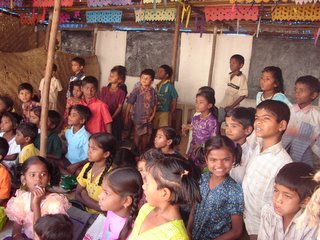
Welcome to the Mastan Nagar Neighborhood Primary School!
This blog chronicles the establishment of a primary school in a slum neighborhood in Hyderabad, India. This neighborhood is near Hy-Tech City, where many of the American and European software companies have large offices with thousands of Indian employees.
The children and their families welcomed the new school on November 2, 2005.
The "school" is a thatched hut with blackboards painted on the walls, but a new building will be up in 2006! We got the news today we have the go-ahead to build very soon.
The first temporary school, well, it fell down. After three days of heavy rains, the plastic-sheeting roof caved in and the whole thing skewed to the right and crashed into the brick wall of the little one-room apartments next door. All our teachers happen to live right there. Their husbands went out in the rain to try to push the thing right side up again, but we had to start all over in the morning.
I asked Kalpana if this was inauspicious. She said she didn't believe in those things. You've got to love her.
So Ismail, our majordomo at Casa Gilbert, was cracking the whip and getting a team to mix cement, dig new pole holes, and get things into shape. In a few hours, he had the whole thing straightened out with the correct pitch to the roof and everything.
During all this, I stumbled around and looked earnest. After all, I still don't speak Telegu.
This school is partially funded by the government (operating expenses) and partially by private donations (physical buildings and extra teachers, Kalpana arranges most of that). I get to help with teacher training, recruiting students, reassuring the parents, organizing volunteers, teaching English on occasion, and general administration. I throw in as many teaching aids and tools as I can find.
This was all Kalpana's idea. She has a long history of working with slum children and their parents. First, she gains their confidence by just sticking around, playing a few simple games and helping in whatever way she can. Then she teaches them, wherever they are, under a tree or in a hut. Finally, she convinces them to pack the bookbags and go to a real school. Then she realized that the schools here stink. Bad. Stinky, stinky, stinky...no money and the poor teachers are orphaned from good management the moment they leave their universities. The student-teacher ratio is around 100 to 1 in most cases, 40 to 1 in the best cases.
Kalpana had an idea. Find a neighborhood that had nothing, no schools or teachers or even buildings. Then, build each link in the chain. Gain their confidence, teach them, then send them to a real good school. She is sure we can build a real good school together. Kalpana is shaking down the local government for every rupee she can get, tapping into every government scheme (that means "plan" here in Indian English) from school lunch provisions to assistant teachers. I'm riding shotgun on all this bureaucratic head-hunting and it is so fun. It is my job to "look fierce." She has pulled every government official into supporting this new school. With good management, we are sure to surpass the poor, orphaned government schools out there. And then we are sure to draw students away from the local, rather unregulated, "private" schools that charge 200 rupees a month. We were aiming for 100 students, now we're aiming for 250.
Comments
Post a Comment
Leave a Message